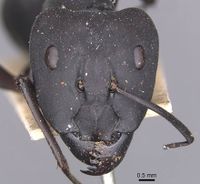Camponotus somalinus
| Camponotus somalinus | |
|---|---|

| |
| Scientific classification | |
| Kingdom: | Animalia |
| Phylum: | Arthropoda |
| Class: | Insecta |
| Order: | Hymenoptera |
| Family: | Formicidae |
| Subfamily: | Formicinae |
| Tribe: | Camponotini |
| Genus: | Camponotus |
| Species: | C. somalinus |
| Binomial name | |
| Camponotus somalinus André, 1887 | |
| Subspecies | |
| |
Identification
Collingwood and Agosti (1996) - This black species is like Camponotus fellah but has more body hairs and there are 8-12 hairs on the ventral head compared with C. fellah where there are 2-4. This pilosity difference occurs in all castes.
Distribution
Latitudinal Distribution Pattern
Latitudinal Range: 23.613333° to -5.06666°.
| North Temperate |
North Subtropical |
Tropical | South Subtropical |
South Temperate |
- Source: AntMaps
Distribution based on Regional Taxon Lists
Afrotropical Region: Eritrea, Kenya, Somalia (type locality).
Palaearctic Region: Oman.
Distribution based on AntMaps
Distribution based on AntWeb specimens
Check data from AntWeb
Countries Occupied
| Number of countries occupied by this species based on AntWiki Regional Taxon Lists. In general, fewer countries occupied indicates a narrower range, while more countries indicates a more widespread species. |

|
Estimated Abundance
| Relative abundance based on number of AntMaps records per species (this species within the purple bar). Fewer records (to the left) indicates a less abundant/encountered species while more records (to the right) indicates more abundant/encountered species. |

|
Biology
Castes
Nomenclature
The following information is derived from Barry Bolton's Online Catalogue of the Ants of the World.
- somalinus. Camponotus somalinus André, 1887: 280 (s.w.) SOMALIA.
- Type-material: syntype major and minor workers (numbers not stated).
- Type-locality: Somalia: (“Pays des Somalis”) (no further data).
- Type-depository: MNHN.
- [Misspelled as somalicus by Stitz, 1911b: 392, Santschi, 1935b: 275.]
- Menozzi, 1930b: 117 (m.).
- Combination in C. (Myrmoturba): Forel, 1914a: 267;
- combination in C. (Tanaemyrmex): Emery, 1925b: 100.
- Status as species: Emery, 1892a: 120; Dalla Torre, 1893: 253; Mayr, 1893: 195; Mayr, 1895: 150; Emery, 1895a: 180; Emery, 1896d: 370 (in list); Emery, 1897e: 604; Emery, 1899a: 500; Emery, 1901e: 63; Mayr, 1904b: 11; Mayr, 1907b: 20; Forel, 1911d: 371; Santschi, 1914b: 132; Wheeler, W.M. 1922a: 961; Emery, 1925b: 100; Menozzi, 1927f: 361; Menozzi, 1930b: 116; Santschi, 1935b: 275; Finzi, 1939a: 167; Menozzi, 1939c: 107; Menozzi & Consani, 1952: 69; Bolton, 1995b: 124; Collingwood & Agosti, 1996: 374; Hita Garcia, et al. 2013: 205; Borowiec, L. 2014: 42 (see note in bibliography); Madl, 2019: 14.
- Distribution: Eritrea, Ethiopia, Kenya, Oman, Somalia, Tanzania, Yemen.
- Current subspecies: nominal plus curtior, pattensis.
Description
References
- André, E. 1887. Description de quelques fourmis nouvelles ou imparfaitement connues. Rev. Entomol. (Caen) 6: 280-298 (page 280, worker described)
- Borowiec, L. 2014. Catalogue of ants of Europe, the Mediterranean Basin and adjacent regions (Hymenoptera: Formicidae). Genus (Wroclaw) 25(1-2): 1-340.
- Collingwood, C. A. and D. Agosti. 1996. Formicidae (Insecta: Hymenoptera) of Saudi Arabia (part 2). Fauna Saudi Arabia. 15:300-385.
- Emery, C. 1925d. Hymenoptera. Fam. Formicidae. Subfam. Formicinae. Genera Insectorum 183: 1-302 (page 100, Combination in C. (Tanaemyrmex))
- Forel, A. 1914a. Le genre Camponotus Mayr et les genres voisins. Rev. Suisse Zool. 22: 257-276 (page 267, Combination in C. (Myrmoturba))
- Menozzi, C. 1930b. Formiche della Somalia italiana meridionale. Memorie della Societa Entomologica Italiana 9: 76-130 (page 117, male described)
References based on Global Ant Biodiversity Informatics
- André E. 1887. Description de quelques fourmis nouvelles ou imparfaitement connues. Rev. Entomol. (Caen) 6: 280-298.
- Collingwood, C. A. and D. Agosti. 1996. Formicidae (Insects: Hymenoptera) of Saudi Arabia (Part 2) Fauna of Saudi Arabia 15: 300-385.
- Collingwood, C. A., and Donat Agosti. "Formicidae (Insecta: Hymenoptera) of Saudi Arabia (Part 2)." Fauna of Saudi Arabia 15 (1996): 300-385.
- Finzi B. 1939. Materiali zoologici dell'Eritrea raccolti da G. Müller durante la spedizione dell'Istituto Sieroterapico Milanese e conservati al Museo di Trieste. Parte III. Hymenoptera: Formicidae. Atti del Museo Civico di Storia Naturale di Trieste 14: 153-168.
- Garcia F.H., Wiesel E. and Fischer G. 2013.The Ants of Kenya (Hymenoptera: Formicidae)Faunal Overview, First Species Checklist, Bibliography, Accounts for All Genera, and Discussion on Taxonomy and Zoogeography. Journal of East African Natural History, 101(2): 127-222
- Madl M. 2019. Notes on the ant fauna of Eritrea (Insecta: Hymenoptera: Formicidae): type specimens deposited in the Natural History Museum Vienna (Austria) and a preliminary checklist. Ann. Naturhist. Mus. Wien, B 121: 9-18.
- Menozzi C. 1927. Raccolte mirmecologiche dell'Africa orientale conservate nel Museo Civico di Storia Naturale Giacomo Doria di Genova. Parte I. Formiche raccolte dal Marchese Saverio Patrizi nella Somalia italiana ed in alcune località dell'Africa orientale inglese. Annali del Museo Civico di Storia Naturale Giacomo Doria. 52: 356-362.
- Menozzi C. 1930. Formiche della Somalia italiana meridionale. Memorie della Società Entomologica Italiana. 9: 76-130.
- Menozzi C. 1939. Hymenoptera Formicidae. Missione Biologica nel Paese dei Borana. 3: 97-110.
- Menozzi C., M. Consani. 1952. Missione biologica Sagan-Omo diretta dal Prof. E. Zavattari. Hymenoptera Formicidae. Rivista di Biologia Coloniale 11: 57-71.
- Santschi F. 1935. Hymenoptera. I. Formicidae. Mission Scientifique de l'Omo 2: 255-277.
- Sharaf M. R., B. L. Fisher, H. M. Al Dhafer, A. Polaszek, and A. S. Aldawood. 2018. Additions to the ant fauna (Hymenoptera: Formicidae) of Oman: an updated list, new records and a description of two new species. Asian Myrmecology 10: e010004
- Wheeler W. M. 1922. Ants of the American Museum Congo expedition. A contribution to the myrmecology of Africa. VIII. A synonymic list of the ants of the Ethiopian region. Bulletin of the American Museum of Natural History 45: 711-1004





